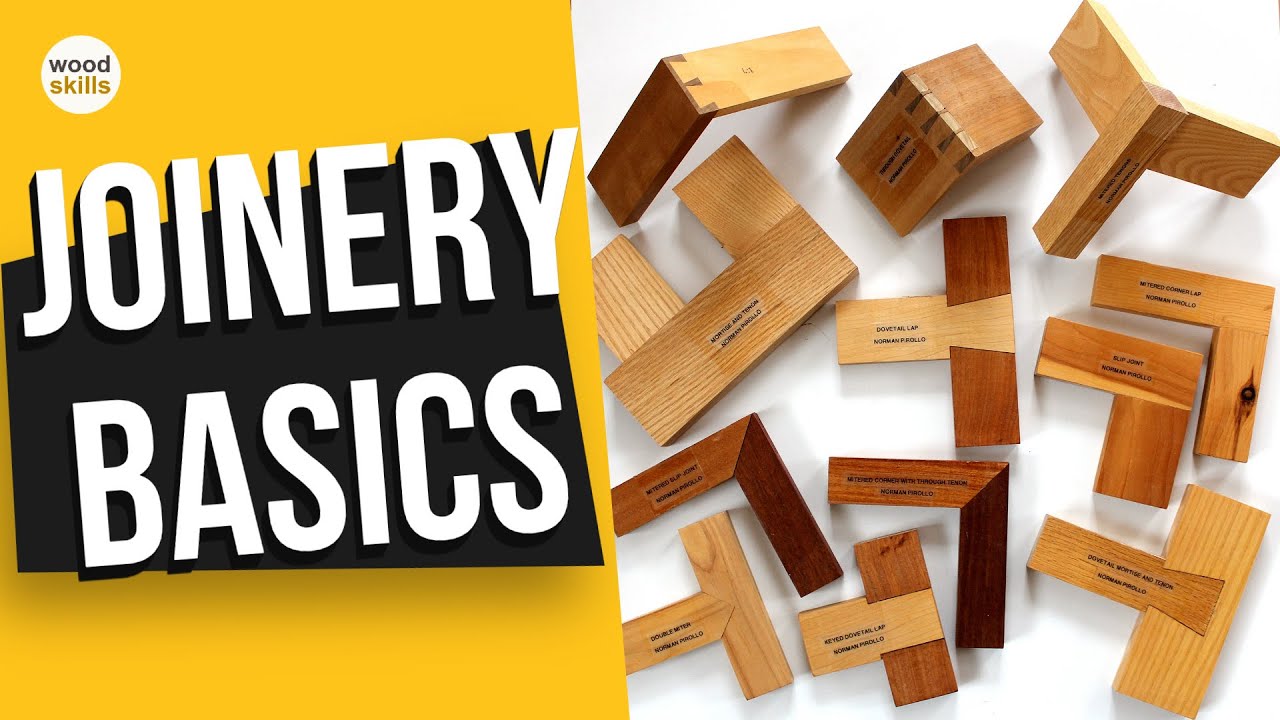This woodworking guide was created by Norman Pirollo from WoodSkills. It’s an in-depth overview of essential wood joinery techniques, including both traditional and modern methods used in furniture and cabinetry.
Strong joinery is at the heart of successful woodworking. Whether you’re building a table, cabinet, or drawer, choosing the right joint can make all the difference in strength, appearance, and longevity.
Watch the full video and subscribe to Norman’s channel:
What Is Wood Joinery?
Joinery refers to the technique of connecting two pieces of wood. The best joints strike a balance between strength and appearance and are chosen based on the material, the purpose of the piece, and the tools available.
Some joints are decorative as well as functional, while others are hidden and purely structural. Understanding how each joint works helps ensure your projects last for years.
Frame and Panel Construction
Frame and panel construction is a staple in furniture making, especially for doors and cabinet panels. The frame is built from stiles and rails, with a floating panel held in place inside.
This setup allows for seasonal wood movement without causing stress on the structure. Mortise and tenon joints are commonly used in this method, often with a haunched tenon to reinforce the connection and conceal the groove.
Mortise and Tenon Joint Variations
The full mortise and tenon is one of the strongest joints available. It consists of a tenon (a rectangular tongue) that fits snugly into a mortise (a cavity). Following the “thirds rule,” the tenon width is typically two-thirds the width of the mating piece.
A popular variation is the wedged mortise and tenon joint, which includes kerfs in the tenon and small wedges that expand the joint when tapped into place. This adds both strength and visual appeal, especially in exposed joinery.
Dowel Joinery
Dowels are a simple and effective way to join two boards without cutting tenons. Holes are drilled in each mating surface, and dowels are inserted with glue to create a hidden joint.
This method is great for cabinet construction and smaller projects. While some woodworkers now favor loose tenons, dowels remain a reliable and affordable option, especially when paired with jigs for accuracy.
Loose Tenon Joinery
Loose tenon joinery is a modern adaptation of the traditional mortise and tenon. Instead of forming the tenon on one piece, a separate tenon is inserted into mortises cut in both mating boards.
This technique speeds up the process, especially when using a dedicated tool like a Domino joiner. When glued in place, the tenon swells to create a strong mechanical bond.
Dovetail Joinery
Dovetails are widely used in drawers and boxes and are known for their interlocking strength. The half-blind dovetail hides the joinery from the front while maintaining excellent durability.
A common ratio is 1:6 for softwoods and 1:7 for hardwoods, which affects the angle of the dovetail. Through dovetails, which expose the joint, are another strong and visually striking option for corners and carcasses.
Slip Joints for Added Strength
Slip joints are used when extra surface area is needed for gluing. In a basic slip joint, a tenon passes through a mortise, offering a secure fit and large bonding area.
This method is ideal for cabinets and frame construction. A double slip joint can also be used to double the contact area and enhance stability.
Miter Joints and Miter Slip Joints
Miter joints are clean and elegant, especially in picture frames and trim work. However, without reinforcement, they’re prone to splitting.
A miter slip joint improves strength by combining angled cuts with a through tenon. This results in a joint that’s both attractive and highly durable.
More complex versions can include a reinforced tenon hidden inside the miter, providing additional strength without sacrificing visual appeal.
Decorative and Advanced Joints
Advanced joinery techniques like dovetail laps or key lap joints are often used in fine furniture and rail construction. These joints provide strength and visual flair at once.
They’re particularly useful in post-to-rail assemblies where both alignment and aesthetics are key. Learning these techniques can add a signature look to your builds.
Choosing the Right Joint
Not all joints are right for every situation. The type of project, wood species, expected stress, and visual preferences should all influence your choice.
Start by mastering a few key joints—mortise and tenon, dowels, and dovetails—before moving into advanced territory. Each joint has its role and learning when and how to use them will improve both the structure and appearance of your work.
Final Thoughts
Good joinery is what separates temporary builds from heirloom furniture. By understanding the strengths of different woodworking joints, you can improve your craftsmanship and expand your project capabilities.
From traditional mortise and tenon to more modern approaches like loose tenons, there’s a joint for every task. Practicing these methods and experimenting with variations will sharpen your skills and elevate your work.
Support Norman by visiting his website: https://www.woodskills.com/
